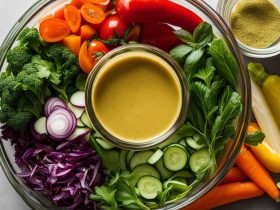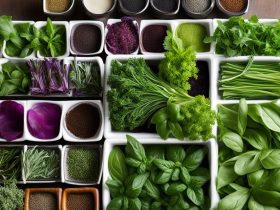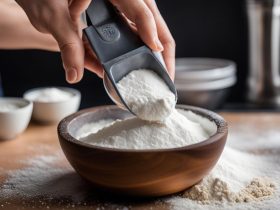Making your own salad dressing at home is easy and allows for endless flavor combinations. With just a few ingredients, you can create a delicious and healthy dressing to elevate any salad. In this guide, we’ll provide you with 9 simple homemade salad dressing recipes that are quick, easy, and packed with flavor.
Key Takeaways:
- Creating your own salad dressing at home allows for customization and personalization of flavors.
- Homemade dressings are typically healthier, as they don’t contain preservatives or artificial additives.
- Basic ingredients for homemade dressings include olive oil, vinegar, acid, and seasonings.
- Classic dressing recipes include ranch, vinaigrette, honey mustard, and blue cheese.
- Emulsifying the dressing and adjusting flavors are key tips for making the perfect dressing.
Why Make Your Own Salad Dressing?
Making your own salad dressing offers several advantages. Firstly, it gives you the freedom to experiment with different flavors and ingredients, allowing you to create dressings that suit your personal taste preferences.
Additionally, homemade dressings are typically healthier than store-bought versions, as they do not contain preservatives or artificial additives. By using fresh, natural ingredients, you can ensure that your dressings are packed with nutrients and free from unnecessary chemicals.
Finally, making your own salad dressing allows you to make small batches, saving you from having to commit to a large bottle that may go to waste. This not only reduces food waste but also ensures that your dressing is always fresh and flavorful.
When you make your own salad dressing, the possibilities are endless. You can experiment with different herbs, spices, and oils to create unique and delicious dressings that will take your salads to the next level.
So why settle for store-bought dressings when you can easily create your own homemade salad dressings? Get creative in the kitchen and enjoy the satisfaction of a homemade dressing that elevates your salads to new heights.
The Basic Ingredients
Most homemade salad dressings consist of a few basic ingredients that can be easily found in your pantry. These include:
- Olive oil
- Vinegar (such as red wine, white wine, or apple cider vinegar)
- A type of acid (such as lemon juice or Dijon mustard)
- Seasonings like salt, pepper, and garlic
These simple ingredients form the foundation of homemade dressings, allowing you to create a variety of flavors to suit your taste. Additionally, depending on the specific dressing recipe, you can customize it further by adding herbs, spices, and sweeteners. The possibilities are endless!
Example Dressing Recipes:
| Homemade Caesar Salad Dressing | Homemade Ranch Dressing Recipe |
|---|---|
| Ingredients: | Ingredients: |
|
|
| Instructions:
1. In a bowl, whisk together mayonnaise, Parmesan cheese, lemon juice, Dijon mustard, garlic, salt, and pepper. 2. Adjust seasonings to taste. 3. Refrigerate for at least 30 minutes before serving. |
Instructions:
1. In a bowl, whisk together mayonnaise, sour cream, buttermilk, dill, chives, garlic, salt, and pepper. 2. Adjust seasonings to taste. 3. Refrigerate for at least 30 minutes before serving. |
Classic Salad Dressing Recipes
Looking for quick and easy homemade salad dressing ideas? Here are some classic recipes that you can whip up in no time. Each recipe offers a unique flavor profile, allowing you to switch up your salads and keep things interesting.
| Dressing | Ingredients |
|---|---|
| Ranch Dressing | Buttermilk, mayonnaise, garlic powder, onion powder, dried dill, dried parsley, salt, black pepper |
| Creamy Italian Dressing | Mayonnaise, white vinegar, olive oil, dried basil, dried oregano, garlic powder, salt, black pepper |
| Classic Vinaigrette | Olive oil, red wine vinegar, Dijon mustard, garlic clove, salt, black pepper |
| Roasted Garlic Dressing | Roasted garlic, lemon juice, olive oil, Dijon mustard, salt, black pepper |
| Honey Mustard Dressing | Mayonnaise, Dijon mustard, honey, white wine vinegar, salt, black pepper |
| Honey Poppy Seed Dressing | Honey, white wine vinegar, olive oil, poppy seeds, Dijon mustard, salt, black pepper |
| Asian Sesame Dressing | Sesame oil, soy sauce, rice vinegar, honey, garlic clove, ginger, salt, black pepper |
| Peanut-Lime Dressing | Peanut butter, lime juice, soy sauce, rice vinegar, honey, garlic clove, ginger, red pepper flakes |
| Creamy Blue Cheese Dressing | Mayonnaise, sour cream, blue cheese, white wine vinegar, Worcestershire sauce, garlic powder, salt, black pepper |
These classic salad dressing recipes are just a starting point. Feel free to tailor them to your taste preferences by adding or reducing ingredients. Get creative and have fun experimenting with different flavors!
Now that you have an arsenal of homemade salad dressing recipes, you can easily elevate your salads and enjoy fresh and flavorful dressings. Say goodbye to store-bought dressings and hello to delicious homemade creations.
Tips for Making the Perfect Dressing
When it comes to creating the perfect homemade salad dressing, there are a few tips that can help you achieve delicious results every time. Follow these guidelines to make your dressing emulsify, adjust the flavors to your liking, and ensure optimal freshness.
Emulsify the Dressing
Emulsifying is a crucial step in making homemade salad dressing. It involves thoroughly combining the oil and vinegar (or other acidic ingredient) so that they don’t separate. To achieve emulsification, you can either whisk the ingredients vigorously or use a blender or food processor. Whisking by hand allows you to control the texture and thickness of the dressing, while blending creates a smoother and more uniform consistency.
Adjust the Flavors
One of the advantages of making your own dressing is the ability to customize the flavors according to your taste preferences. Feel free to experiment with different types of vinegar, oils, and seasonings to create unique combinations. You can adjust the acidity by adding more vinegar or lemon juice, sweetness with a touch of honey or maple syrup, and saltiness by tasting and adding a pinch of salt as needed. This way, you can create a dressing that complements your salad perfectly.
Proper Storage
To maintain the freshness and quality of your homemade dressing, it’s important to store it correctly. After making the dressing, transfer it to a clean, airtight container and store it in the refrigerator. This will help preserve its flavor and prevent any bacterial growth. It’s recommended to use the dressing within 1-2 weeks for optimal freshness. Before using, give the dressing a good shake or stir to ensure it is well mixed.
Store-Bought vs Homemade Dressings
While store-bought dressings offer convenience, making your own dressing at home has many benefits. Homemade dressings can be customized to your liking and allow you to control the quality of ingredients used. Store-bought dressings often contain added sugars, preservatives, and artificial flavors, which can be avoided with homemade versions. Additionally, homemade dressings are often more cost-effective, as you can make small batches and reduce waste.
By making your own salad dressing, you have the freedom to experiment with different flavors and tailor the dressing to suit your taste preferences. You can choose to use high-quality, organic ingredients, ensuring that your dressing is both delicious and nutritious. With homemade dressings, you can avoid the artificial additives and unhealthy ingredients often found in store-bought options.
Making your own dressing also allows you to make small batches, so you only make what you need. This not only reduces waste but also ensures that your dressing is always fresh and flavorful. Homemade dressings can be stored in the refrigerator for up to a week, allowing you to enjoy them throughout the week without compromising on taste or quality.
Here is a comparison between store-bought and homemade dressings:
| Store-Bought Dressings | Homemade Dressings | |
|---|---|---|
| Taste | May contain artificial flavors and additives that can alter taste | Can be customized to suit your taste preferences |
| Quality | May contain low-quality ingredients | Allows you to select high-quality ingredients |
| Nutrition | May contain added sugars and preservatives | Can be made with wholesome, nutritious ingredients |
| Cost | Can be more expensive, especially for high-quality options | Cost-effective, as you can make small batches |
By choosing to make your own dressing, you can enjoy the benefits of a flavorful, nutritious, and cost-effective option. With the variety of homemade dressing recipes available, you’ll never get bored and can always find a dressing to complement your salads perfectly.
Using Homemade Dressings for More Than Salads
Homemade salad dressings aren’t just limited to salads. They can be used in various ways to enhance the flavors of your meals. Don’t confine yourself to using dressings solely on greens; get creative and experiment with different ways to incorporate homemade dressings into your cooking.
One great way to utilize homemade dressings is as marinades for meat. The combination of flavors and seasonings in the dressings adds depth and tenderness to your meats, taking them to a whole new level of deliciousness. Simply coat your preferred meat with the dressing, let it marinate for a few hours or overnight, and then cook it to perfection.
Another option is to drizzle your homemade dressings over roasted vegetables. The tangy and savory flavors will complement the natural sweetness of the vegetables, creating a mouthwatering side dish. Whether it’s roasted carrots, Brussels sprouts, or cauliflower, a little homemade dressing can elevate the flavors and make your veggies truly shine.
Looking for a tasty dip for bread or crudites? Homemade dressings come to the rescue once again. With their creamy and flavorful properties, they make delicious and healthy dipping options. Whether you’re serving a fresh baguette or a platter of fresh cut veggies, your homemade dressings will add a burst of flavor and make your appetizers even more enticing.
So, don’t limit yourself to just using homemade dressings on salads. Let your culinary creativity flow and explore the various ways you can incorporate these dressings into your meals. Whether as marinades, drizzles, or dips, homemade dressings are versatile and a fantastic addition to your culinary repertoire.

Make Your Own Salad Dressing Printables
To make it even easier for you to create your own homemade dressings, we’ve created a handy printable guide that includes all the basic ingredients and measurements. This guide will ensure that you have everything you need at your fingertips to whip up delicious homemade dressings whenever you desire. Simply download and print the guide, and you’ll have a convenient reference for all your salad dressing needs.
With our printable guide, you’ll have access to a diverse collection of homemade salad dressing recipes. Whether you’re in the mood for a tangy vinaigrette, a creamy Caesar dressing, or a zesty ranch dressing, our guide has got you covered. You can also use the blank space provided to write down your own favorite dressings and variations, making it a personalized resource that perfectly suits your taste.
homemade salad dressing recipe
Here’s a preview of what you’ll find in our homemade salad dressing printables:
| Salad Dressing Recipe | Ingredients | Measurements |
|---|---|---|
| Vinaigrette | Olive oil, red wine vinegar, Dijon mustard, garlic, salt, pepper | 1/4 cup, 2 tablespoons, 1 teaspoon, 1 clove, to taste, to taste |
| Caesar Dressing | Mayonnaise, Parmesan cheese, lemon juice, garlic, Worcestershire sauce, Dijon mustard | 1/4 cup, 1/4 cup, 2 tablespoons, 2 cloves, 1 teaspoon, 1 teaspoon |
| Ranch Dressing | Mayonnaise, sour cream, buttermilk, garlic powder, onion powder, dried dill, dried parsley, salt, pepper | 1/2 cup, 1/2 cup, 1/2 cup, 1/2 teaspoon, 1/2 teaspoon, 1/2 teaspoon, 1/2 teaspoon, to taste, to taste |
These are just a few examples of the delicious dressings you can create using our printables. With clear and concise instructions, you’ll be able to follow each recipe with ease, ensuring successful results every time. Say goodbye to store-bought dressings and hello to the satisfaction of making your own.
Remember, our homemade salad dressing printables are designed to enhance your culinary experience and provide endless options for creating flavorful dressings. So why wait? Download the guide now and start elevating your salads with easy homemade dressings.
Conclusion
Making your own salad dressing is a simple and rewarding way to elevate your salads and add flavor to your meals. By following these easy homemade salad dressing recipes, you can say goodbye to store-bought dressings and enjoy the delicious taste of homemade creations.
Experiment with different flavors and ingredients to create dressings that suit your personal taste preferences. Whether you prefer a tangy vinaigrette, a creamy ranch, or a zesty Italian dressing, the possibilities are endless. With just a few basic pantry ingredients, you can whip up a homemade dressing in no time.
Not only are homemade dressings incredibly flavorful, but they are also healthier than their store-bought counterparts. By making your own dressings, you have control over the quality of ingredients used, avoiding added sugars, preservatives, and artificial flavors. Plus, by making small batches, you can reduce waste and ensure optimal freshness.
So why settle for ordinary when you can create extraordinary dressings right at home? Take control of your salads and elevate your meals with these easy homemade salad dressing recipes. Say goodbye to store-bought dressings and hello to the delicious taste of homemade goodness.
FAQ
Why should I make my own salad dressing?
Making your own salad dressing allows you to customize the flavors and ingredients to suit your taste preferences. Homemade dressings are typically healthier and do not contain preservatives or artificial additives.
What are the basic ingredients for homemade salad dressing?
The basic ingredients for homemade salad dressing include olive oil, vinegar, an acid like lemon juice or Dijon mustard, and seasonings like salt, pepper, and garlic.
What are some classic homemade salad dressing recipes?
Some classic homemade salad dressing recipes include ranch dressing, creamy Italian dressing, classic vinaigrette, roasted garlic dressing, honey mustard dressing, honey poppy seed dressing, Asian sesame dressing, peanut-lime dressing, and creamy blue cheese dressing.
What are some tips for making the perfect salad dressing?
It’s important to emulsify the dressing by whisking or blending the ingredients together. You can adjust the acidity, sweetness, and saltiness to suit your taste. Leftover dressing should be stored in the refrigerator and used within 1-2 weeks.
How does homemade dressing compare to store-bought dressings?
Homemade dressings can be customized and use high-quality ingredients, while store-bought dressings may contain added sugars, preservatives, and artificial flavors. Homemade dressings can also be more cost-effective when made in small batches.
Can I use homemade dressings for more than just salads?
Yes, homemade dressings can be used as marinades, drizzled over roasted vegetables, or used as dips for bread or crudites.
Are there printables available for making homemade dressings?
Yes, we have created a printable guide with all the basic ingredients and measurements for homemade dressings. You can download and print the guide for easy reference.
Related Articles
- read our blog foodandcooking.my.id , FB and IG












Leave a Reply